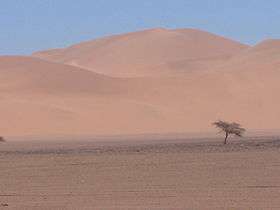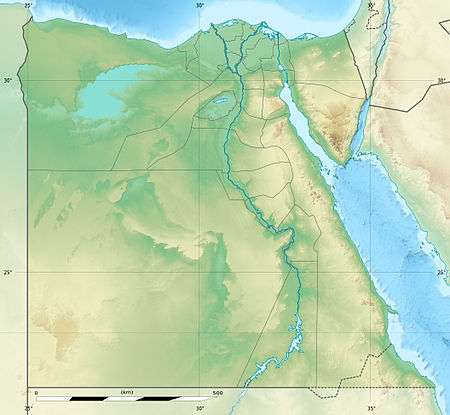Gabal Elba
| Gabal Elba | |
|---|---|
| جبل علبة | |
 | |
| Highest point | |
| Elevation | 1,435 m (4,708 ft) |
| Coordinates | 22°11′16″N 36°22′14″E / 22.18778°N 36.37056°ECoordinates: 22°11′16″N 36°22′14″E / 22.18778°N 36.37056°E |
| Geography | |
 Gabal Elba Location in Egypt | |
| Location | Egypt |
Gabal Elba (Arabic: جبل علبة Gabal ʿElba Egyptian Arabic pronunciation: [ˈɡæbæl ˈʕelbæ], "Mountain Box") or Elba Mountain is a peak and, in general, includes the associated mountainous area in the Hala'ib Triangle area. Despite being claimed by both Egypt and Sudan, the area is currently under Egyptian control.
Geography
The higher peaks in the area are Gabal Elba itself (1,435 m), Gabal Shellal (1,409 m), Gabal Shendib (1,911 m) and Gabal Shendodai (1,526 m).[1]
Average annual rainfall in the region is less than 50 mm, but orographic precipitation in and around Gabal Elba itself amounts to as much as 400 mm. in the upper areas.[2] This phenomenon owes to the vicinity of the Red Sea coast (some 15–30 km east of the mountains) and also to the fact that the coast, slightly curved to the east at this point, presents an unusually broad front to the sea across a 20–25 km strip of relatively flat land[2] which facilitates interception of moisture-laden north-east sea winds.
This phenomenon is registered at its best in the northeast of the region, where Gabal Elba is located, which explains the fact that Gabal Elba receives higher precipitation than other coastal mountains in the range, including higher ones. Aridity gradually increases to the southwest of the area.[1]
Ecology
Gabal Elba's summit is a “mist oasis” where much of the precipitation is contributed in the form of dew, mist and clouds, creating a unique ecosystem not found anywhere else in the country. Indeed, Gabal Elba is a "biodiversity hotspot",[3] with a biological diversity unparalleled in any terrestrial environment in Egypt proper. The relative abundance of moisture supports a diverse flora of some 458 plant species – almost 25% of plant species recorded for the entire country.
Many Afrotropical elements have their northern limits at Gabal Elba,[2] and the dense cover of acacias and other scrubs represents the only natural woodland in Egypt. There is at least one endemic species of plant (Biscutella elbensis).
Gabal Elba National Park
The Gabal Elba National Park,[4] declared by Egypt in 1986, covers some 3,560,000 hectares,[1] including most of the disputed Hala'ib Triangle (except its westernmost corner), and an area of comparable size just north of it. It is also known to potentially hold the last population of the Nubian wild ass. However, the purity of these animals is questionable.
References
- 1 2 3 "EG023: Gabal Elba". Sites - Important Bird Areas (IBAs). Birdlife International. 2009. Retrieved 2012-03-17.
- 1 2 3 "Gebel Elba". Egypt's Biodiversity: Habitats. Ministry of State for Environmental Affairs: Nature Conservation Sector BioMAP Project 2005-2007 . External link in
|publisher=(help) - ↑ "Biodiversity Conservation Capacity Building in Egypt" (PDF). EEAA (Egyptian Environmental Affairs Agency). 2006. p. 16. Archived from the original (PDF) on November 4, 2009. Retrieved 2009-03-08.
- ↑ Ghabbouri, Samir I., ed. (Sep 1997). Identification of Potential Natural Heritage Sites (PDF). National UNESCO Commission, Egypt. p. 27. Retrieved 2009-03-08.
External links
- Istvan Moldovan; Jacqueline Burrell; Dick Hoek; Daniel Mauras; Mary Megalli; Bernhard Pusch (April 2010). "Gebel Elba Ornithological Survey 3- 10 of April 2010" (PDF). Trip Reports. Travellingbirder.com. Retrieved 2012-03-17.